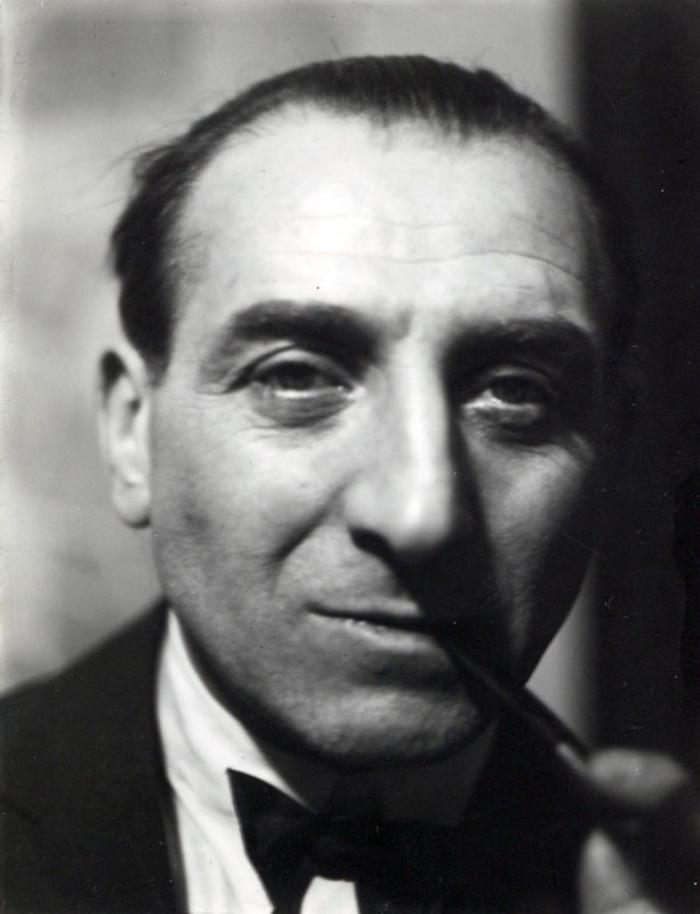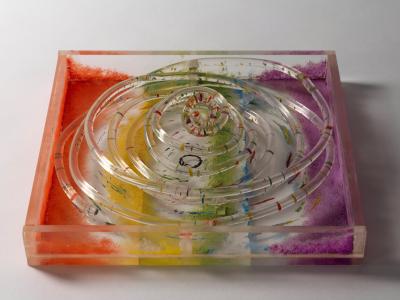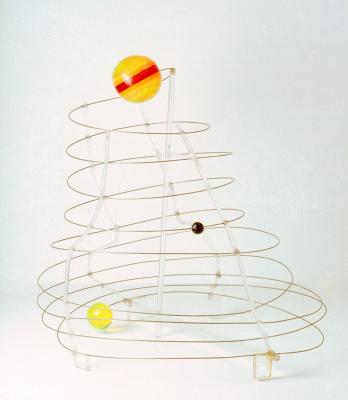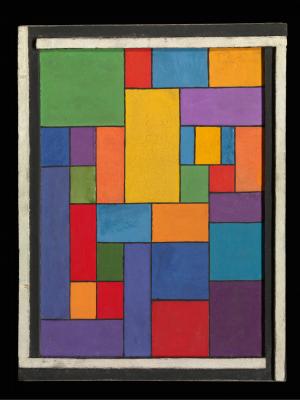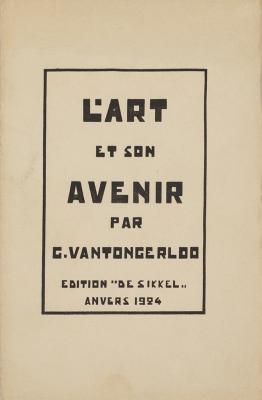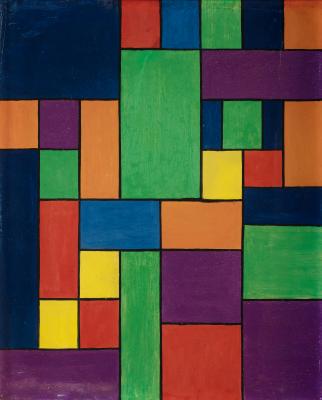Georges Vantongerloo is internationally known as the most important abstract artist and theorist from Belgium. With works in the collections of the Centre Pompidou (Paris), the Guggenheim Museum and the Museum of Modern Art (both in New York), the Philadelphia Museum of Art and the Kröller-Müller Museum (Otterlo), among others, he is the ambassador of the Belgian abstract.
Strictly speaking, Vantongerloo does not belong to the movement of the Pure Plasticism. Just as with Marthe Donas, Vantongerloo begins his avant-garde period abroad. He begins as a sculptor after studies in Antwerp and Brussels. Subsequently he moves to Holland during World War I and comes into contact with the artists of De Stijl, in which he shall play an important role. He settles in Menton (South France) and works in Paris along with Michel Seuphor on the group exhibition Cercle et Carré (1930). One year later he forms Abstraction-Création with Auguste Herbin. Vantongerloo is taken up in all important international exhibitions in the years 1930-40: Cubism and Abstract Art in the MoMa (1936), Abstracte Kunst in the Stedelijk Museum of Amsterdam and Konkrete Kunst in the Kunsthalle of Basel (1944).
Vantongerloo, who ascribes to the abstract language of form after 1917, applies himself to Abstract Art in order to get control of rules by which he develops an interest in geometrical relationships and algebraic formulas. In addition to his artistic practice, Vantongerloo also writes theoretical work about his research. Primarily after the publication of his pamphlet L’Art et son Avenir in 1924, he creates new impulses for geometric abstraction with his writings. In this way, for example, he subjects three neo-plastic works of Piet Mondriaan (1872 - 1944) to an analysis in the French publication Vouloir. In this way he opens up the way for his own ‘mathematical’ abstraction.
For twenty years Vantongerloo works as a painter and sculptor on his oeuvre and restricts himself to horizontal and vertical lines. The three-dimensional translation of this play of lines leads him to architectural concepts that he attempts to incorporate in urban projects for bridges and airports. Around 1937, after he distances himself from the straight line in favour of the curved line, principles continue to determine his work, but his work takes on a larger, lyrical freedom. His latest works are fresh and playful. He uses new materials, such as Plexiglas and plastic, and plays with transparency, colour and light. The use of spirals leads Vantongerloo’s research to ‘immeasurable’ space.
Despite his impact on the development of 20-century art, Vantongerloo remains ‘the great unknown’ for the general public, as his colleague and protégé Max Bill called him already in 1962.
1886
Fransciscus Georgius Leonardus Vantongerloo is born on 24 November in Antwerp.
1900 - 1909
From 1900 he studies general and drafting studies at the Academy for Fine Arts in Antwerp. Beginning in 1903, he follows a four-year course of sculptural art and works in the studio of sculptor Emile Jespers, father of fellow student Oscar.
In 1905, he moves to Brussels, where he enrols at the Academy of Fine Arts. Completes his military service from 1906 to 1909.
1909 - 1914
Vantongerloo survives on a means of grants, including a work grant by the royal court. Beginning in 1911, he exhibits figurative sculptures in exhibitions in Charleroi, Liege and Brussels. In 1914, he participates in the General World’s exhibition in Ghent with Portrait of M.J..
Following the invasion on 4 August 1914 of the German army, Vantongerloo is reinstated. He is wounded by a gas attack and is discharged from the army in October 1914.
Escapes to the Netherlands. He lives in Wassenaar and then The Hague.
Participates in the alternative salons that the Belgian government organises for artists in exile. Vantongerloo receives various praising reviews for his portraits.
1915 - 1917
Via Willem Paerels, meets Futurist Jules Schmalzigaug in The Hague in the Comité Belge. Vantongerloo continues making conventional works for the Belgian elite in exile and the Netherlandish bourgeois. He has his first one-man exhibition.
Becomes acquainted with Futurism and the theories of Filippo Tommaso Marinetti (1876 - 1944) via Schmalzigaug. Shortly thereafter, the latter commits suicide.
Is involved in a dispute with his future father-in-law. The fight escalates and results in a prison sentence. After his release, Vantongerloo receives a second solo exhibition with sculptures and paintings. On 28 November 1917 he marries Tine (Woutrina) Kalis.
1918 - 1922
In March 1918, Vantongerloo learns about the publication De nieuwe beweging in de schilderkunst by Theo Van Doesburg. Immediately afterwards, Vantongerloo visits Van Doesburg (1883 - 1931).
Begins with his theoretical writings. A first version of Science et Art, an article that appears in July 1918 in De Stijl, under the title of Réflexions. In the series of texts that he makes for De Stijl (1918 - 1920), he abandons the figurative in favour of an abstract aesthetic.
Exhibits the abstract image Construction dans la sphère at the exposition Belgische Moderne Kunst in the Stedelijk Museum of Amsterdam (end of 1918). The work is later replaced with a work by Van Doesburg.
After the armistice, the Vantongerloo couple moves to Brussels. He writes the first chapters of L’art et Son Avenir and begins to assemble his ideas about colours. He visits Gino Severini in 1919 in Paris and corresponds with him afterwards.
In December 1919, De Stijl publishes two works by Vantongerloo, Construction des rapports des volumes. They quickly obtain an iconic status thanks to the distribution by Van Doesburg. Vantongerloo introduces Van Doesburg’s lecture Classique-Baroque-moderne in Antwerp (19 February 1920). It is the beginning of the Pure Plasticism in Flanders.
Moves to Menton (Southern France) for health reasons. On the way he meets Piet Mondriaan for the first time. Embarks upon a study of mathematics.
1923 - 1927
Publication of L’Art et son Avenir in 1924, an edition by De Sikkel Uitgeverij in Antwerp. For several years he is occupied with primarily being a theoretician.
Michel Seuphor stays for a few weeks with the Vantongerloo couple in Menton. In 1927, a conflict between Van Doesburg and Mondriaan causes a break with Van Doesburg.
1928 - 1946
Vantongerloo moves from Menton to Paris, whereupon he collaborates with Seuphor in 1930, Mondriaan and Luigi Russolo (1885 - 1947) with the Cercle et Carré exhibition in Galerie 23. In 1931 he becomes Vice-president of the artists association Abstraction-Création, a function that he serves until 1936.
Develops a strong interest for architecture and city building. Corresponds with the Belgian Premier Henri Jaspar regarding a bridge project for the connecting of the Schelde’s bank in Antwerp. His models of bridges and an airport were exhibited at Cercle et Carré and L’Art mural in 1935, inter alia.
Vantongerloo’s titles change in content. Gradually the references shift from geometrical schemes to algebraic formulas. Towards the end of his life, general descriptions, such as Variantes or Courbes, prevail. The introduction of the curve in his paintings from 1937 onwards allows him to create a more open space.
Beginning in 1929, Vantongerloo is taken up in many important exhibitions and his finds an association with the new generation of abstract working artists. A few examples: Abstrakte en Surrealistische Malerei und Plastik (Kunsthaus Zürich, 1929), AC Internationell Utställning av Post-Kubistik Konst (1930, Stockholm), L’Art Mural (Paris, 1935), Cubism and abstract Art (Museum of Modern Art, New York, 1936), Kunsthalle Basel (1937), Abstrakte Kunst (Stedelijk Museum of Amsterdam, 1938), Art Non-Objectif (Galerie Charpentier, Paris, 1939) and 1er Salon des Réalités Nouvelles (Paris, 1946).
1949 - 1964
After WWII, Vantongerloo is highly productive. He exhibits 60 works, along with Max Bill (1908 - 1994) and Antoine Pevsner (1884 - 1962) in the Kunsthaus Zürich.
Declines to participate in the exhibition De eerste abstrakten in België by the group G 58 in the Antwerp Hessenhuis. He also distances himself from Seuphor’s book Abstracte kunst in Vlaanderen (1963).
Uses plastic and Plexiglas for the first time.
Vantongerloo is picked up for a series of overview exhibitions such as Konkrete Kunst—50 Jahre Entwicklung (Helmhaus, Zürich). Takes part in the Biennial for Sculptural Art in Paris in 1960 and in 1962 receives a retrospective exhibition in the Marlborough Fine Art gallery in London.
1965
Vantongerloo dies in Paris on 5 October 1965.
Sergio Servellón
CC-BY-NC (Creative Commons 4.0)
